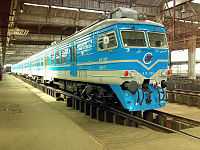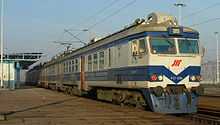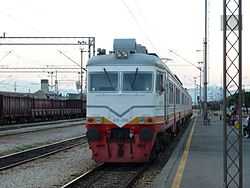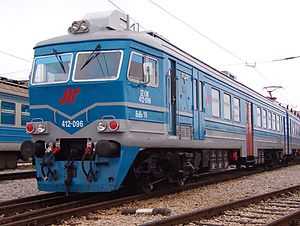ŽS series 412
| ŽS 412/416 (ex JŽ 412/416) | |
|---|---|
|
JŽ 412 096 | |
| Type and origin | |
| Power type | Electric |
| Builder | Rīgas Vagonbūves Rūpnīca |
| Build date | 1980 – 1990's |
| Total produced | 53 |
| Specifications | |
| UIC classification | Bo'Bo' + 2'2' + 2'2' + Bo'Bo' |
| Gauge | 1,435 mm (4 ft 8 1⁄2 in) |
| Length | 25,540 mm (83 ft 10 in) (one car) |
| Width | 3,120 mm (10 ft 3 in) |
| Height | 3,893 mm (12 ft 9 in) |
| Locomotive weight | 55 tonnes (54 long tons; 61 short tons) |
| Current collection method | Pantograph |
| Performance figures | |
| Maximum speed | 120 km/h (75 mph) |
| Career | |
| Class |
JŽ 412, ŽS 412, ŽCG 412, MŽ 412 |
| Nicknames | Gorbačov |
| Locale | Yugoslavia, in today's Serbia, Macedonia and Montenegro |
The RVR class 412/416 is an electric multiple unit built for Yugoslav Railways. The units are now used by Serbian Railways, Macedonian Railways and Montenegro Railways.
History
In the early 1980s Yugoslav Railways have ordered number of passenger electric multiple unit trains for Belgrade, Novi Sad, Skoplje and Titograd sections (ŽTP). As twice cheaper from domestic Yugoslav competitor, JŽ series 410 EMU built by Goša, the Soviet ER-31 built by Rīgas Vagonbūves Rūpnīca was chosen. The first unit was introduced in traffic at September 25, 1980. EMU was designated as JŽ 412/416.
In period from 1980 to 1990 and breakup of Yugoslavia 50 EMU train sets were delivered from Soviet Union to Yugoslav railways. ŽTP Belgrade and ŽTP Novi Sad received 43 sets, while ŽTP Titograd received six and ŽTP Skopje received four sets of 412/416 EMU. During the 1990s ten more sets were ordered, but due the sanctions on FR Yugoslavia, only three were delivered while seven were sold to Bulgarian State Railways.
Technical specifications
The EMU train set consists from four sections: two motor cars (412) and two cab-trailer cars (416). The trains could be controlled and operated only from cab cars.
Voltage
This train set utilises 25 kV/50 Hz AC.
Operators
After dissolution of Yugoslavia, class 412/416 EMU train sets continued service with railways of Serbia, Montenegro and the Republic of Macedonia.
Serbia
Today Serbian Railways are the biggest operator of 412 class of all Yugoslav successor states. Main depot for this class is at Zemun.
In late 2012 there were 24 EMU train sets operational. Nine sets were overhauled with help of Belgrade city, being used with BG VOZ - urban rail system that is operated by the public transit system of Belgrade and is a part of the integrated BusPlus system. Four sets are operated with Beovoz, while the rest of EMU train sets traffic on inter-city lines toward Novi Sad, Prijepolje, Šid, Paraćin and Priboj.
-

Serbian Railways ŽS 412
-

Beovoz in different livery
-
Serbian Railways ŽS 412 on railway bridges in the Belgrade railway junction network
Montenegro
Montenegro Railways have received six class 412/416 EMU train sets which have been purchased by Yugoslav Railways for ŽTP Titograd in 1985. Today there are three operational train sets and two awaiting overhaul. Main depot is at Podgorica. One train set was destroyed in the Bioče dissaster in 2006.
-

Railway transport of Montenegro class 412 EMU train set
References
External links
| ||||||||||||||||||||||||||
| ||||||||||||||||||||||||||
| Wikimedia Commons has media related to JŽ 412. |

